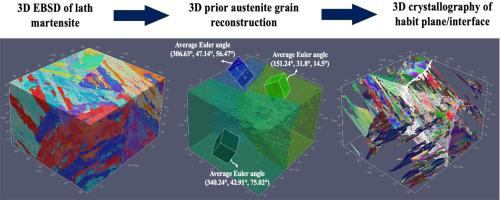Three-dimensional analysis of local and dominant habit planes in a lath martensitic stainless steel
IF 2.9
Q2 MATERIALS SCIENCE, MULTIDISCIPLINARY
引用次数: 0
Abstract
The three-dimensional (3D) morphology of lath martensite in a low-carbon 13Cr–4Ni stainless steel (CA6NM alloy) was reconstructed using large-volume Xe+ plasma focused ion beam (PFIB) serial sectioning tomography in combination with electron backscatter diffraction (EBSD). This approach enabled a detailed analysis of both dominant and local habit planes (HPs), offering new insights into their spatial distribution and variation. The dominant HP, determined by averaging the normal directions of high-angle block boundaries (BBs) within packets and across multiple prior austenite grains (PAGs), was found to lie between {111}γ and {557}γ, with an orientation of (0.51,0.52,0.66)γ. However, local HP analysis at individual BBs revealed significant deviations from both orientations in certain regions of the microstructure. 3D morphological observations indicated that bending within specific blocks directly contributed to these local HP variations. It is suggested that interactions between adjacent growing blocks, either through spatial interference and growth competition within a single packet, or hard impingement between blocks from different packets, affect growth paths, ultimately leading to block bending and the macroscopic deflection of interface planes. These findings highlight the intricate interplay between microstructural evolution and crystallographic constraints during martensitic transformation, demonstrating the effectiveness of large-scale 3D characterization in capturing complex microstructural phenomena that are difficult to resolve through conventional 2D analyses.

板条马氏体不锈钢局部和主导习惯面的三维分析
采用大体积Xe+等离子体聚焦离子束(PFIB)连续断层扫描结合电子背散射衍射(EBSD)技术,重建了低碳13Cr-4Ni不锈钢(CA6NM合金)板条马氏体的三维形貌。这种方法能够详细分析显性和局部习惯面(HPs),为它们的空间分布和变化提供新的见解。通过平均包内和多个先前奥氏体晶粒(PAGs)内高角块边界(BBs)的法向确定的优势HP位于{111}γ和{557}γ之间,取向为(0.51,0.52,0.66)γ。然而,在个别BBs上的局部HP分析显示,在微观结构的某些区域,这两个方向都有显著的偏差。三维形态学观察表明,特定块内的弯曲直接导致了这些局部HP变化。研究表明,相邻生长块之间的相互作用,无论是通过单个包内的空间干扰和生长竞争,还是来自不同包的块之间的硬碰撞,都会影响生长路径,最终导致块弯曲和界面平面的宏观挠曲。这些发现强调了马氏体相变过程中微观结构演变和晶体学约束之间复杂的相互作用,证明了大规模3D表征在捕获复杂微观结构现象方面的有效性,这些现象很难通过传统的2D分析来解决。
本文章由计算机程序翻译,如有差异,请以英文原文为准。
求助全文
约1分钟内获得全文
求助全文
来源期刊

Materialia
MATERIALS SCIENCE, MULTIDISCIPLINARY-
CiteScore
6.40
自引率
2.90%
发文量
345
审稿时长
36 days
期刊介绍:
Materialia is a multidisciplinary journal of materials science and engineering that publishes original peer-reviewed research articles. Articles in Materialia advance the understanding of the relationship between processing, structure, property, and function of materials.
Materialia publishes full-length research articles, review articles, and letters (short communications). In addition to receiving direct submissions, Materialia also accepts transfers from Acta Materialia, Inc. partner journals. Materialia offers authors the choice to publish on an open access model (with author fee), or on a subscription model (with no author fee).
 求助内容:
求助内容: 应助结果提醒方式:
应助结果提醒方式:


